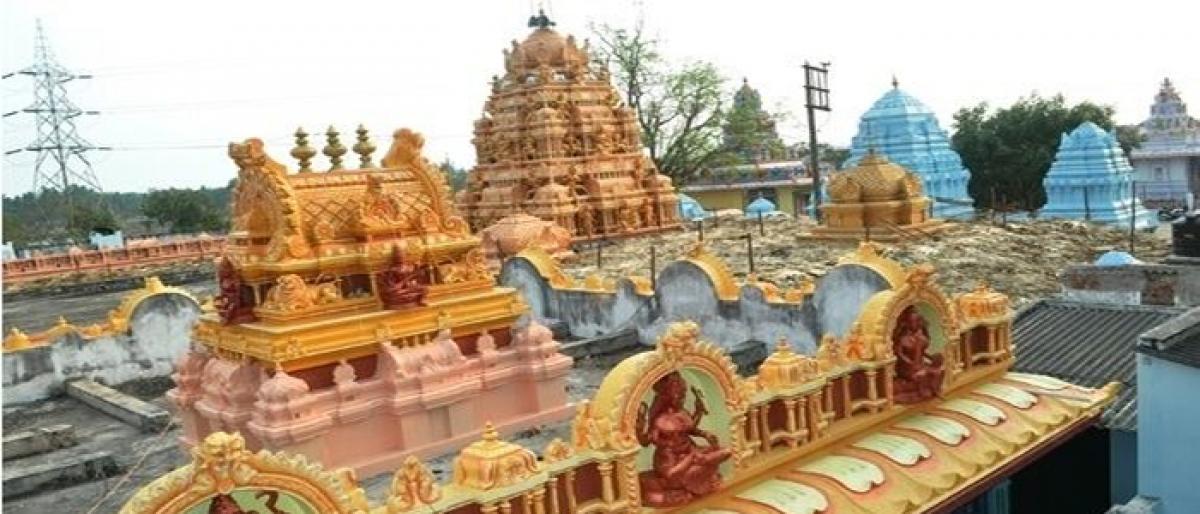உ
அவிநாசி சேவூர் அறம்வளர்த்தநாயகி சமேத வாலீஸ்வரர் ஆலயம்
அறமற்றதுறையில் சிண்டிகேட்
இந்துசமய அறநிலைய ஆட்சித்துறை என தாந்தோணித்தனமாக அழைத்துக்கொள்ளும், இந்துசமய அறக்கட்டளைகள் நிர்வாகத்துறையின் (HINDU RELIGIOUS CHARITABLE ENDOWMENTS DEPARTMENT) மீதான பலவிதமான குற்றச்சாட்டுகள் மற்றும் அதுசார்ந்த வழக்குகள் கடந்த பத்துவருடங்களாக நடைபெற்று வருகிறது நாம் அனைவரும் அறிந்ததே.அறநிலையத்துறையின் பலவிதமான முறைகேடுகள் பலவிதமான சிண்டிகேட் (கூட்டு செயல்) மூலம் நடைபெறுகிறது.
1. சாதாரண கோயில் சிலை திருட்டு - (செயல் அலுவலர்-குருக்கள்- வாட்ச்மேன்-அறங்காவலர்-கட்சி அறங்காவலர்)
2. திருப்பணி மூலம் திருட்டு - (ஆணையர்-செயல் அலுவலர்-அறங்காவலர்-உபயதாரர்-ஸ்தபதி)
3. பலவித உண்டியல்கள் மூலம் கள்ள பணம் - (செயல் அலுவலர்-உள்ளூர் அரசியல் பிரமுகர்-அறங்காவலர்)
4. தரிசன டிக்கெட் மூலம் திருட்டு - (ஆணையர்-செயல் அலுவலர்-அரசியல் பிரமுகர்-அறங்காவலர்)
5. கல்யாண டிக்கெட் மூலம் திருட்டு (ஆணையர்-செயல் அலுவலர்-உள்ளூர் அரசியல் பிரமுகர்கள்-அறங்காவலர்)
6. பிரசாத கடை மூலம் திருட்டு (செயல் அலுவலர்-உள்ளூர் வியாபாரிகள்-அரசியல் பிரமுகர்கள்)
7. பரிகார கடைகள் மூலம் திருட்டு - (ஆணையர் -செயல் அலுவலர் - பரிகார வியாபாரிகள் )
8. பரிகார ஸ்தலம் மூலம் திருட்டு - (ஆணையர் - செயல் அலுவலர் - வரலாறு ஆசிரியர் - குருக்கள்)
9. நகைகள் கொள்ளை - (ஆணையர் - தணிக்கையாளர் -அறங்காவலர் -அரசியல் பிரமுகர்-செயல் அலுவலர்-கருவூல மெய்காவலர்)
10. கோயில் நிலம் விற்பனை மூலம் கொள்ளை - (அரசு ஆட்சியர் - தாசில்தார் - செயல் அலுவலர் - ஆணையர்)
11. கோயில் நில வாடகை கொள்ளை - (ஆணையர் - தணிக்கையாளர் - செயல் அலுவலர் -குத்தகைதாரர்)
12. கோயில் தணிக்கை மூலம் கொள்ளை - (அரசு - ஆணையர் - தணிக்கையாளர் - அரசியல்வாதிகள்)
இப்படி அறமற்ற துறையின் சிண்டிகேட் நூதனமான கொள்ளைகளை அடுக்கிக்கொண்டே போகலாம். இதனை சாதாரண மக்களுக்கோ, ஏன் நீதிபதிகளோ புரிந்துகொள்வது கடினமானது.
இப்படிப்பட்ட கொள்ளைகளில் நமது சேவூர் வாலீஸ்வரர் கோயிலில் நடக்கும் கொள்ளை மற்றும் அராஜகம், கொள்ளையை சிண்டிகேட்டை உடைக்க முற்படுகையில் பொங்கும் அறமற்ற துறை அதிகாரிகள் அவர்கள் மிரட்டல்கள் போன்றவற்றை இங்கு விவரிக்கிறோம்.
கொங்கேழு சிவஸ்தலங்களுள் அவிநாசி மிகவும் புகழ் பெற்ற ஸ்தலமாகும். அவிநாசிக்கு வடக்கே 12 கிலோமீட்டர் தொலைவில் இருக்கும் செம்பியங்கிழானடி நல்லூர் என்ற சேவூர் என்ற ரிஷபகிரி மிகவும் பிரசித்தி பெற்ற தேவார வைப்பு ஸ்தலமாகும். ஒருமுறை மதுரை உமையொருபாகனார் சொக்கநாதப்பெருமானும் மீனாக்ஷியும் ஆகாயமார்க்கமாக இவ்வழியே செல்கையில், சிங்கமொன்று ரிஷபத்தின் மீது ஏறி விளையாடிக்கொண்டிருந்தது. இக்காட்சியை கண்ட உமாதேவியார் அவ்விடத்தில் அளப்பரிய திவ்யத்துவம் இருப்பதாக எண்ணி அவ்விடத்தில் குடிகொண்டார். சேய் ஆன ரிஷபம் மேல் சிங்கம் விளையாடியதால் சேவூர் என்றும் மாட்டூர் என்றும் ரிஷபகிரி என்றும் வழங்கப்படுகிறது. பின்பு வாலி பூஜை செய்தததால் வாலீஸ்வரர் என்றும், காபாலிகர்கள் இவ்விடத்தில் பெருமானுக்கு பூஜை செய்து வந்ததால் கபாலீஸ்வரர் என்ற பெயருடனும் அழைக்கப்படுகிறது என்ற தகவலை COL .மெக்கென்சி யின் சேகரித்த ரிஷபகிரி மான்மியம் தெரிவிக்கிறது.
இக்கோயிலானது கொங்கு சோழன் வீர சோழனின் 11 ஆம் நூற்றாண்டு காலத்தில் கட்டப்பட்டதாகும். தஞ்சை சோழர் ராஜராஜ சோழனின் பாட்டியான செம்பியன்மாதேவி பிறந்த ஊர் மற்றும் சமாதி அடைந்த ஊராகும். இக்கோயிலில் மார்கழி மாதம் திருவாதிரை அன்று செம்பியன்மாதேவி உற்சவர் முன்பு இன்றும் திருக்கல்யாண வைபவம் நடந்துவருகிறது. இன்றும் செம்பியன்மாதேவி உறவின் முறையாருக்கு இத்திருக்கல்யாண வைபவத்தில் பரிவட்டம் கட்டப்படும் நிகழ்ச்சி பரம்பரையாக நடந்துவருகிறது. இது பெரும் வரலாற்று சிறப்பாகும்.
பரம்பரை ஸ்தாணீ கம்
பரம்பரை அறங்காவலர்
இந்துசமய அறநிலையத்துறை செய்ல் அலுவலரின் சிண்டிகேட்
பரம்பரை ஸ்தாணீ கர் மாற்றம் 2005
ஸ்தாணீ கர் மாற்றம் 2017
ஆகம விதிமீறல் - கிராம மக்கள் கொதிப்பு
உதவி ஆணையர், செயல் அலுவலர் உள்ளூர் பிரமுகர் சிண்டிகேட்
புதிய ஸ்தாணீ க குருக்கள் தேடல்
வாலீஸ்வரர் கோயிலில் 2005 ஆண்டு வரை அவருக்கு தெரிந்து நான்கு தலைமுறைகளாக பரம்பரை ஸ்தாணீ கராக கௌசிக கோத்திரத்து குருக்கள் இருந்து வந்தார். இவர் இக்கோயில் குருத்துவமுடைய வலையபாளைய ஆதீனத்து பங்காளிகள் ஆவார்.
பரம்பரை அறங்காவலர்
இக்கோயிலுக்கு பரம்பரை அறங்காவலராக கைக்கோல முதலி குடும்பம் ஒரு தலைமுறைக்கு வரை இருந்துள்ளார். ஒருசமயம் இக்கோயில் தேர் தீப்பிடித்து எரிந்ததால் பரம்பரை அறங்காவலர் சித்தம் கலங்கி மனநோய்வாய்ப்பட்டு பரம்பரை அறங்காவலர் பொறுப்பை தற்போது கோயிலில் மேற்பார்வை செய்துவரும் திரு.தேவராஜ் (சிண்டிகேட்டில் இருப்பவர்) என்பவரின் தந்தைக்கு பொறுப்பை தற்காலிகமாக கொடுத்துவிட்டார்.
இந்துசமய அறநிலையத்துறை செய்ல் அலுவலரின் சிண்டிகேட்
இக்கோயில் தினப்படி பூஜைக்காக ரூ.750/பிரதி தினம் அரசு உதவி பெரும் கோயில். இக்கோயிலுக்கு 90 சென்ட் வயல் அழுக்குளி கிராமத்தில் உள்ளது. அங்கிருந்து வரும் நெல்லை கொண்டு பெருமானுக்கு நித்ய பூஜைகள் நடைபெற்று வந்தது. தற்போது அறநிலையத்துறையால் இக்கோயிலில் கட்சி சார்பாக உள்ள அறங்காவலர்கள் நிர்ணயிக்கப்பட்டு நிர்வகிக்கப்படுகிறது. கடந்தமுறை 2010 வரை அறங்காவலர் குழு இருந்தது. கடந்த எட்டுவருடங்களாக செயல் அலுவலர் மற்றும் இக்கோயிலுக்கு பரம்பரை அறங்காவலரால் விடப்பட்ட திரு.தேவராஜ, திரு.சண்முகசுந்தரம், திரு.நடராஜ கவுண்டர் ஆகியோர் செயல் அலுவலருடன் சிண்டிகேட்டாக செயல்பட்டு கோயிலை நிர்வகித்து வருகின்றனர். தற்போது இரண்டரை ஆண்டுகளாக திரு.சந்திரமோகன் ( 9944101104 ) என்பவர் செயல் அலுவலராக தற்போதைய வாலீஸ்வரர் சிண்டிகேட்டில் உள்ளார். இவர் அருகில் உள்ள மொண்டிபாளையம் பெருமாள் கோயில், அன்னூர் மண்ணீஸ்வரர் கோயில், குமரன்குன்று கல்யாண சுப்பிரமணியர் கோயில் ஆகிய பல கோயில்களுக்கும் செயல் அலுவலராக உள்ளார். திருப்பூர் மாவட்டத்தில் இக்கோயில் அமைந்துள்ளதால் திருப்பூர் மாவட்ட உதவி இயக்குனர் மேற்பார்வையில் இக்கோயில் வருகிறது. தற்போது திருமதி.ஹர்ஷினி ( 9524244923 ) என்பவர் உதவி ஆணையராக உள்ளார்.
செயல் அலுவலர் திரு.சந்திரமோகன்
பரம்பரை ஸ்தாணீ கர் மாற்றம் 2005
நான்கு தலைமுறையாக ஸ்தானீகம் பார்த்து வந்த கௌசிக கோத்திரத்து குருக்களுக்கு வாரிசு இல்லாததால் பரம்பரை ஸ்தாணீ கத்திற்கு குருக்கள் இல்லாமல் போய் பழனி கோயிலில் ஸ்தாணீக செய்துவந்த நடராஜ குருக்கள் என்பவரை 2005 ஆன் ஆண்டு அப்போதைய செயல் அலுவலர் பொது மக்கள் அனுமதியுடன் நியமித்தார்.
ஸ்தாணீ கர் மாற்றம் 2017
2017 ஆம் ஆண்டு நடராஜ குருக்கள் மீது மது அருந்தி பூஜை செய்கிறார் என்ற தகவல் செயல் அலுவலருக்கு ஊர் பொது மக்கள் தெரிவித்தனர். பலமுறை கண்டித்தும் அவர் தனது பழக்கத்தை மாற்றாமையால் அவரை கோயில் பூஜையிலிருந்து விளக்கி வைக்க செயல் அலுவலர் முடிவு செய்தார். நடராஜ குருக்களுக்கு சிண்டிகேட்டில் உள்ள தேவராஜ் & co மூலம் நடராஜ குருக்களுக்கு மாதம் 10,000 ரூபாய் மற்றும் வீட்டு வாடகை 2,000 ரூபாய் என மாத சம்பளம் பெற்று வந்துள்ளார். இந்துசமய துறை அவருக்கு சம்பளம் கொடுக்கவில்லை என்பது குறிப்பிடத்தக்கது.
ஆகம விதிமீறல் - கிராம மக்கள் கொதிப்பு
இந்நிலையில் சிவாலய வழக்கப்படி புதிய குருக்களை நியமிக்க செயல் அலுவலர், தன சிண்டிகேட்டை பயன்படுத்தி தாளக்கரை பெருமாள் கோயிலில் அங்குள்ள அர்ச்சகர்களும் அசிஸ்டண்டாக இருந்த திரு.ஆதிசேஷன் என்ற வைணவரை வாலீஸ்வரர் கோயிலின் அர்ச்சகராக நியமித்தார். சிவாலய ஸ்தாணீகம் என்பது குருக்கள் என்னும் சிவாச்சாரியார்களை கொண்டு நேம நிஷ்டையுடன் செய்யவேண்டிய ஆத்மார்த்த பணியாகும். ஆனால், கயவர்கள் துறை குருக்களை வெறும் அர்ச்சகர் என்றே அழைப்பதை வாடிக்கையாக கொண்டுள்ளனர். செயல் அலுவலரின் சிண்டிகேட்டான திரு.ஆதிசேஷன் பெருமானுக்கு பூஜை செய்து விபூதி தட்டினை கீழே வைத்து விடுவார். விபூதியை அள்ளித்தரமாட்டார். இதனால் சேவூர் பக்தர்கள் வருந்தினர். அதோடு நான் செயல் அலுவலரின் அர்ச்சகர் மக்கள் சொல்வதையெல்லாம் கேட்கமுடியாது என்று முரண்டு பிடித்துள்ளார். ஆகம விதிகளை மீறி சிவாச்சாரியாரை நியமிக்காமல் ஆறு மாத காலம் ஆதிசேஷன் என்பவரை நியமித்ததை சில பக்தர்கள் எதிர்க்க ஆரம்பித்தனர்.
உதவி ஆணையர், செயல் அலுவலர் உள்ளூர் பிரமுகர் சிண்டிகேட்
இந்நிலையில், இக்கோயிலுக்கு 7 வருடங்கலாக அறங்காவலர் குழு இல்லாத நிலையில், 7 வருடங்களாக சம்பளம் கொடுத்துவரும் திரு.தேவராஜ் & co மற்றும் செயல் அலுவலர் முத்த உதவி ஆணையர் வரை ஒரு சிண்டிகேட் அமைத்து வைத்துக்கொண்டு கோயிலை தங்கள் பிடிக்குள் கொண்டுவந்ததுடன், கோயிலுக்குள் சட்டவிரோதனமான திருமணம் மற்றும் வசூல், சட்டவிரோதமான சந்தைக்கடை உள் ஏலம் என நடத்தி கொள்ளையடித்து வந்தனர். இந்த பணம் காய்ச்சி வழிமுறைக்கு ஆதரவாக (உடந்தையாக) கோயில் அர்ச்சகர் இருக்கும் வகையில் இந்த ஆகம விதி மீறல் நியமனம் நடைபெற்றது பின்புதான் பொது மக்களுக்கு தெரிய வந்தது.
மேற்குறிப்பிட்ட செம்பியன்மாதேவி உறவின்முறையார் திரு.சிவப்பிரகாஷ் கோயிலில் ஆகமவிதிமுறை மீறலை கண்டித்து உதவி ஆணையர் திருமதி.ஹாசினிக்கு மனு அளித்தார். ஆனால், எந்த பதிலும் வரவில்லை. பின்பு சிவப்பிரகாச ஆவார்கள் உதவி ஆணையர் இது பற்றி காசினி அவர்களிடம் வினவ, அவர்களோ "எதுக்கு இப்படி பெட்டிஷன் போட்டு ஒரு அலுவலரின் வேலைக்கு உலை வைக்கிறீங்க ?" என்று கூறி இருக்கிறார். கோயிலின் புனிதத்தன்மை ஆகமம் எல்லாம் இரண்டாம் பட்சம்தான் போல. இவர்களுக்கு நல்ல வசூல் மட்டுமே முக்கியம் என்பது உதவி ஆணையர் பேச்சில் தெரிகிறது. உதவி ஆணையர் அப்போதே திரு.சிவப்பிரகாஷ் அவர்கள் முன்பு செயல் அலுவலருக்கு போன் செய்து சிவாச்சாரியாரை நியமிக்க வேண்டியுள்ளார். அதற்கு, செயல் அலுவலர் சிவாச்சாரியார்கள் யாரும் கிடைக்கவில்லை என்று பதிலளித்துள்ளார். அதன் பின்பு சிவப்பிரகாஷ் அவர்கள் சிவாச்சார்யார்களை நாங்கள் தேர்ந்தெடுத்து உங்களிடம் அனுப்புகிறோம் என்று கூறிவிட்டு வந்துவிட்டார்.
புதிய ஸ்தாணீ க குருக்கள் தேடல்
அதன் பின்பு செயல் அலுவலரோ, உதவி ஆணையரோ ஆதிசேஷனை அகற்றவும் குருக்களை நியமிக்கவும் மெத்தனம் காட்டி வந்தனர். இந்நிலையில் சிவப்பிரகாஷ் அவர்கள் உள்ளூர் மக்கள் சிலருடன் கலந்தாலோசித்து கோபிச்செட்டிபாளையத்தை சேர்ந்த கௌஸிக கோத்திரத்து அரவிந்த் (எ ) சிவாசல குருக்கள் மற்றும் திருமுருகன்பூண்டியை சேர்ந்த பாடசாலைகளில் முறைப்படி தேர்ச்சி பெற்ற இளம் குருக்கள் இருவரை செயல் அலுவலரை சந்திருக்கும்படி அனுப்பியுள்ளார். அவர்களை செயல் அலுவலர் தனது உள்ளூர் சிண்டிகேட்டுகளான தேவராஜ் & co வை வைத்துக்கொண்டு நேர்க்காணல் செய்துள்ளார். நேர்காணலில் குருக்களிடம் நீ சிலையை திருடிக்கொண்டு போய் விட்டால் என்ன செய்வது, உன்னை எப்படி நம்புவது போன்ற கேள்விகளுக்கு பதில் கேட்டுள்ளார். மேலும், குருக்கள் கேட்ட 15000 ரூ./மாதம் எல்லாம் தரமுடியாது என்று கூறி அனுப்ப்பிவைத்துள்ளார். இது போன்று மொத்தம் 7 குருக்களை திரும்ப அனுப்பிய சிண்டிகேட் ஆதிசேஷனை தக்கவைக்க பிரம்மபிராயத்தனம் செய்தனர்.
தொடர்ந்த ஆகம விதி மீறல்
இதை தொடர்ந்து திரு.சிவப்பிரகாஷ் அவர்கள் செயல் அலுவலரின் சிண்டிகேட்களை புறக்கணித்து திரு.குழந்தை வேலு குருக்கள் என்பவரின் சேவூர் கோயில் குருக்கள் பனி காலியிடத்திற்கு விண்ணப்பிப்பதாக கடிதம் மற்றும் பயோ டேட்டாவை செயல் அலுவலருக்கு பதிவு தபாலில் அனுப்பி கோரிக்கை விடுக்க வைத்தார். மேலும், உதவி ஆணையருக்கு இத்தகவலை கூறியுள்ளார். திகைத்து போன செயல் அலுவலர் சிண்டிகேட் வேறு வழியில்லாமல் திரு.குழந்தை வேலு குருக்களை நேர்காணல் செய்தது. அதில் குழந்தை வேலு குருக்கள் தனக்கு சம்பளம் வேண்டாம் எனவும், வெளியில் உள்ள பூஜை, புண்யார்ச்சனைகள் வைத்து தான் பிழைத்து கொள்வதாகவும் கூறியுள்ளார். இதனால், மேலும் திகைத்து போன சிண்டிகேட் ஆதிசேஷனை காப்பாற்ற குருக்களை விஷயத்தை அப்படியே கிடப்பில் போட்டது.
சேவூர் மக்கள் மகாசிவராத்திரியன்று போராட்டம்
இதற்கிடையில் 2018 கடந்த மஹாசிவராத்தியன்று காலை முதல் சேவூர் மக்கள் தகுதியுள்ள குருக்கள் இருந்து விண்ணப்பித்தும் நேர்காணல் செய்தும் ஏன் இன்னும் அவரை நியமிக்கவில்லை என்று செயல் அலுவலரை கேள்விகேட்டனர். சிவப்பிரகாஷ் அவர்கள் இந்த கேள்வியை தொடர்ந்து செயல் அலுவலரிடம் கேட்டு வந்துள்ளார். இந்நிலையில், சிவராத்திரியன்று மாலை இதற்கு ஒரு முடிவு வரவேண்டுமென்று நினைத்து கோயிலின் வெளி சுற்றுச்சுவர் கதவினை பூட்டி மக்களுடன் அறவழி போராட்டத்தில் ஈடுபட்டார். திகைத்து போன ஆதிசேஷன் செயல் அலுவலருக்கு போன் செய்ய செயல் அலுவலர் அங்குள்ள காவல் நிலையத்தை தொடர்புகொண்டு அவர்களையும் தனது சிண்டிகேட்டில் கொண்டு வந்து, ஆதிசேஷன் மூலம் திரு. சிவபிரகாசின் மீது தண்னி தாக்க வந்ததாக புகார் கொடுக்க வைத்தார். காவல் துறையும் சிவப்பிரகாசை கைது செய்து FIR பதிந்தது. எனினும், பொது மக்கள் இதனை விடாமல் உதவி ஆணையருக்கு தெரிவித்து கடிந்துகொள்ள வேறு வழியில்லாமல் இரவு எட்டு மணிக்கு மேல் குழந்தை வேலு குருக்களை வாலீஸ்வரர் கோயிலில் மஹாசிவஅத்திரி பூஜையை செய்ய பணித்தனர்.
காவல்துறை அராஜகம் சிறைவாசம்
காவல்துறை சிவப்பிரகாஷ் அவர்களின் மீது சிண்டிகேட்டின் உதவியுடன் பொய்யான புகாரை அளித்து அவரை இரண்டு நாட்கள் சிறையில் வைத்து சித்ரவதை செய்தனர். இரண்டு நாட்களுக்கு பின்பு ஜாமீனில் வெளியேவிட்டனர்.
செயல் அலுவலர் சிண்டிகேட்டை உடைத்தல்
சிறையில் இருந்து வெளியே வந்த சிவப்பிரகாஷ் இனி இந்த 7 வருட சிண்டிகேட்டை உடைக்க எண்ணி இதுநாளும் நடந்துவரும் முறைகேட்டினை வெளியே கொண்டுவர எண்ணினார்.
போலி கல்யாண ரசீது மூலம் வசூல்
முதல் கட்டமாக தேவராஜ் & co , கடந்த 7 வருடங்களாக செயல் அலுவலருக்கு தெரியாமல் கோயிலில் நடைபெறும் திருமணங்களுக்கு போலி கல்யாண ரசீதுகளை அடித்து மக்களிடம் 2500 ரூ./கல்யாணத்திற்கு வசூல் செய்தது ஒரு பக்தர் மூலம் தெரிய வந்தது. அப்படியானால், வருடத்திற்கு 100 திருமணங்களுக்கு மேல் நடைபெறும் இக்கோயிலில் ரூ.2500 வீதம் ரூ.20 லட்சத்திற்கு மேல் செயல் அலுவலர் ஆசியுடன் ஒட்டுமொத்தமாக சிண்டிகேட் வசூல் செய்ததை பொது மக்களுக்கு அம்பலப்படுத்தினார். இதைக்கண்டு திகைத்துப்போன செயல் அலுவலர் முறையான ரசீது முறையை கொண்டு வந்தார். இதில் செயல் அலுவலர் சிவப்பிரகாஷ் மற்றும் குருக்கள் மீது வன்மம் கொண்டு குருக்களை கோயிலை விட்டு விரட்டிவிடுவேன் என்று மிரட்டினார்.
செயல் அலுவலர் அல்லாத போலி ரசீது வசூல்
ஊராட்சி ஏலம் மூலம் கொள்ளை
அதோடு சேவூர் ஊராட்சியில் சந்தைக்கடை குத்தகைக்கு விட ஏலம் நடத்தி BDO அலுவலகத்தில் ரூ.50,000 க்கு தேவாஜ் & CO ஏலம் எடுத்து அதனை ரூ.3 லட்சத்திற்கு விற்று ரூ.2.5 லட்சம் அதிகம் பெற்று அதனை கோயில் குருக்கள் சம்பளம் கொடுப்பதாக மக்களிடம் கூறி வந்தனர். இந்நிலையில் கோயில் குருக்களுக்கு ரூ.1.5 லட்சம் போனாலும், மீதமுள்ள 1 லட்சமும், கல்யாண போலி ரசீது கணக்கு பணமும் எங்குள்ளது என்று கேட்க திகைத்துப்போனது சிண்டிகேட்.
கோயில் நிலத்து நெல் அபேஸ்
இந்நிலையில் அழுக்குளி எனும் ஊரில் உள்ள 90 சென்ட் நிலத்திலிருந்து நெல் குத்தகையும் கோயிலுக்கு வருவதில்லை செயல் அலுவலர் வசூலிப்பதில்லையா அல்லது வேறெங்காவது போகிறதா என்றும் தெரியவில்லை.
கிடுக்குபிடியில் செயல் அலுவலர் சிண்டிகேட்
இத்தனை புகார்களுக்கு இடையில் சிக்கிய உதவி ஆணையர்-செயல் அலுவலர் - உள்ளூர் பிரமுகர்கள் ஆன இந்த சிண்டிகேட் கதிகலங்கி போனது. ஆனாலும், சிவப்பிரகாஷையும், சம்பளமில்லாமல் வேலை செய்யும் கோயில் குருக்களையும் பழிவாங்க வேண்டும் அதன் வட்டாரங்களில் கூறிவந்தது.
சமாதானம் பேசுதல்
இதற்கிடையில் சந்தைக்கடை ஏலம் வந்த போது சிவப்பிரகாசை அழைத்து சமாதானம் பேசினர் தேவராஜ் & co . இந்த ஒரு தடவை கண்டுகொள்ள வேண்டாம் என கூறினார். அதிக குத்தகைக்கு எடுக்கும் நபர்கள் சந்தைக்கு வரும் விவசாயிகளிடம் நடைமுறைக்கும் மேல் 4 மடங்கு சுங்க கட்டணம் வசூல் செய்து குடியானவன் வயிறில் என் அடிக்கிறீங்க என்று கேட்டுவிட்டு வந்துவிட்டார்.
பொதுமக்கள் சார்பாக அறக்கட்டளை
சிவப்பிரகாஷ் அவர்கள் பத்து ஹிந்து ஜாதிகளை மக்களை ஒன்று திரட்டி 17 பேர் கொண்ட ஒரு அறக்கட்டளையை கோயில் நலனுக்காக பதிவு செய்தார். அதன் மூலம் தினப்படி 3 கால பூஜைக்கான ஜாமங்களை அளித்து வந்தனர். அறக்கட்டளையை பதிவுசெய்த போது செயல் அலுவலர் காவல்துறையிடம் அனுமதியின்றி அறக்கட்டளை பதிவு செய்வதாக புகார் அளிக்க, சப்-இன்ஸ்பெக்ட்டரும் சிவப்பிரகாசை அழைத்து மிரட்டியுள்ளார். அதற்கு சிவப்பிரகாஷ் சட்டப்படி அறக்கட்டளையை பதிவு செய்து தந்த பதிவாளரை கேளுங்கள் என்று கூறியதும் அமைதியானார்.
அறக்கட்டளை மூலமாக பூஜைக்கு பொருள் வழங்க அனுமதி மறுப்பு
புதிய ஸ்தாணீ க குருக்களுக்கு எதிரான மிரட்டல்
கடந்த 9 மாதங்களில் திரு.குழந்தை வேலு குருக்களுக்கு செயல் அலுவலர் பல முறை பல காரணங்களை காட்டி மிரட்டியுள்ளார்.
மிரட்டல் 1 - ஆற்றாமை மிரட்டல்
புதிதாக குழந்தை வேலு குருக்கள் கோயிலில் வழியில்லாமல் பணியில் சேர்த்ததற்காக பொறுக்க முடியாத நிலையில் நான் உன்னை ஒரு வாரத்தில் தூக்குவேன் என்று மிரட்டியுள்ளார்.
மிரட்டல் 2 - அனுமதியின்றி ஹோமம் மிரட்டல்
பொது மக்கள் சார்பாக ஆரம்பிக்கப்பட்ட அறக்கட்டளை மூலம் ருத்ர ஹோமம் செய்வதற்கு தன்னிடம் அனுமதி கேட்காமல் நீர் எப்படி இதற்கு ஒத்துக்கொள்ளலாம் என்று மிரட்டியுள்ளார். ருத்ரஹோமம் முடிந்ததும் உதவி ஆணையர் ஹர்ஷினியும் குருக்களை ஒரு சந்திப்பில் கோயிலில் உங்களை கோயிலை விட்டு தூக்குவோம் என மிரட்டி சென்றுள்ளனர். அவிநாசியை சேர்ந்த அ .தி.மு .க. ஒன்றிய செயலாளர் குருக்களை நீக்கும்படி உதவி ஆணையரிடம் கேட்க, திருப்பூர் முன்னாள் நகரமன்ற செயலாளர் மூலமாக உதவி ஆணையரை போனில் கண்டிக்க, குருக்களை நீக்கும் திட்டம் கைவிடப்பட்டது.
மிரட்டல் 3 - குருக்கள் மேல் பாலியல் குற்றச்சாட்டு
இந்நிலையில் குருக்களுக்கு தவறான தொடர்பு இருப்பதாக தேவராஜ் & co , உதவி ஆணையருக்கு மனு அனுப்பியது. இதன் பேரில் குருக்களை செயல் அலுவலருடன் சேர்ந்து மிரட்ட மக்கள் தலையிட்டு அவர்மீதான குற்றச்சாட்டினை நிரூபிக்க கேட்க உடைந்து போன சிண்டிகேட் ஜகா வாங்கியது.
மிரட்டல் 4 - பக்தர்கள் 6 கால பூஜை செய்ய குருக்கள் சம்மதித்ததற்கு
சேவூர் மக்கள் மற்றும் பக்தர்களின் வேண்டுகோளுக்கு ஏற்ப கோயிலில் ஆறு கால பூஜை செய்ய குருக்கள் உப்புத்தன்மை கொடுத்ததிற்காக, தன்னை கேட்காமல் நீ எவ்வாறு செய்யாலாம் என ஒருமையில் செயல் அலுவலர் திட்டி, ஒரு வாரத்தில் கோயிலை விட்டு தூங்குவதாக சவாலிட்டுள்ளார்.
மிரட்டல் 5 - உடலுபாதையால் குருக்கள் கோயிலுக்கு வர இ யலாமைக்கு
குருக்களுக்கு அல்சர் காரணமாக மருத்துவமனைக்கு சென்று வைத்தியயம் பார்க்கும் போது தன்னிடம் அனுமதி கேட்கவில்லை என்று கூறி உன்னை ஒருவாரத்தில் தூக்குவேன் என்று மிரட்டியுள்ளார்.
மீண்டும் செயல் அலுவலர் சிண்டிகேட்
இத்தனை மிரட்டல்களுக்கு பிறகு எந்த அறிவிக்கையும் அறிவிக்கையும் செய்யாமல் கடந்த 24-11-18 அன்று மாலை குழந்தைவேல் குருக்களிடம் சாவியை பிடுங்கி புதிதாக காசிவிஸ்வநாதன் என்ற வைதீக யாரை மீண்டும் ஆகம விதி மீறலுடன் நியமித்துள்ளார் செயல் அலுவலர். நேற்று காலை கோயிலுக்கு வந்த புதிய அர்ச்சகரிடம் (குருக்கள் அல்லாத) மது வாடை மற்றும் போதையை கண்டு மக்கள் வெகுண்டெழுந்தனர்.
மீண்டும் வாலீஸ்வரர் கோயிலில் உதவி ஆணையர் - செயல் அலுவலர் - உள்ளூர் பிரமுகர்கள் - அர்ச்சகர் சிண்டிகேட் உருவாகியுள்ளது.
26-11-2018 அன்று சிண்டிகேட் செயல் அலுவலர் சிவப்பிரகாஷ் மீது கொடுத்துள்ள புகார்
26-11-2018 அன்று சிண்டிகேட் செயல் அலுவலர் சிவப்பிரகாஷ் மீது கொடுத்துள்ள புகார்
திரு.சிவப்பிரகாஷ் மீது காழ்ப்புணர்வு கொண்ட செயல் அலுவலர் சிண்டிகேட் சிவபிரகாஷ் மீது கோயிலில் அனுமதியின்றி திருநீற்றுப்பச்சை, அரளி போன்ற செடிகளை நட்டதற்காக public nuisance பிரிவின் கீழ் வழக்கு தொடர புகார் அளித்துள்ளார். அதைக்கேட்ட போலீசே அசந்து போய்விட்டனர். 🤩🎃🤪
குழந்தை வேலு குருக்களை மாற்ற செயல் அலுவலர் சிண்டிகேட் சில உள்ளூர் பிரமுகர்களிடம் தனது ஓட்டுநர் மூலமாக கையூட்டு பெற்ற காட்சி.
பெருமானார் இந்த திருவிளையாடல்களை ஏன் நடத்துகிறார் என்று புரியவில்லை. எனினும், இறைவனின் மீது பாரத்தை போட்டு மக்கள் நல்லகாலம் வேண்டிவருகின்றனர்.
இந்து போன்ற பல வகையான சிண்டிகேட்கள் கோயிகளில் கோயில் பூஜை நிர்வாகத்தில் இருந்துகொண்டு மக்களை சுரண்டி வருகின்றனர்.




















